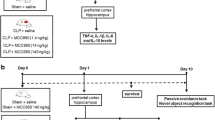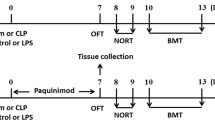Abstract
Among the clinical manifestations observed in septic patients, sepsis-associated encephalopathy (SAE) is probably the most obscure and poorly explored. It is well established, however, that SAE is more prevalent in aged individuals and related to a worse outcome. In this context, we decided to investigate the acute effects of sepsis, induced by cecal ligation and puncture (CLP), on the cerebral transcriptional profile of young and old rats. The idea was to highlight important signaling pathways possibly implicated in the early stages of SAE. Global gene expression analysis of three different brain regions (hippocampus, cerebellum, and cortex) indicated a relatively small interference of sepsis at the transcriptional level. Cerebellum tissue was the least affected by sepsis in aged rats. The increased expression of S100a8, Upp1, and Mt2a in all three brain regions of young septic rats indicate that these genes may be involved in the first line of response to sepsis in the younger brain. On the other hand, altered expression of a network of genes involved in sensory perception of smell in the cortex of aged rats, but not in young ones, indicates an earlier disruption of cortex function, possibly more sensitive to the systemic inflammation. The expression of S100a8 at the protein level was confirmed in all brain regions, with clear-up regulation in septic aged cortex. Taken together, our results indicate that the transcriptional response of the central nervous system to early sepsis varies between distinct brain regions and that the cortex is affected earlier in aged animals, in line with early neurological manifestations observed in older patients.



Similar content being viewed by others
References
Mayr, F.B., S. Yende, and D.C. Angus. 2014. Epidemiology of severe sepsis. Virulence 5 (1): 4–11. https://doi.org/10.4161/viru.27372.
Pinheiro da Silva, F., and M.C.C. Machado. 2017. Septic shock and the aging process: a molecular comparison. Frontiers in Immunology 8: 1389. https://doi.org/10.3389/fimmu.2017.01389.
Pisani, M.A. 2009. Considerations in caring for the critically ill older patient. Journal of Intensive Care Medicine 24 (2): 83–95. https://doi.org/10.1177/0885066608329942.
Umberger, R., B. Callen, and M.L. Brown. 2015. Severe sepsis in older adults. Critical Care Nursing Quarterly 38 (3): 259–270. https://doi.org/10.1097/CNQ.0000000000000078.
Heming, N., A. Mazeraud, F. Verdonk, F.A. Bozza, F. Chretien, and T. Sharshar. 2017. Neuroanatomy of sepsis-associated encephalopathy. Critical Care 21 (1): 65. https://doi.org/10.1186/s13054-017-1643-z.
Feng, Q., Y.H. Ai, H. Gong, L. Wu, M.L. Ai, S.Y. Deng, L. Huang, Q.Y. Peng, and L.N. Zhang. 2017. Characterization of sepsis and sepsis-associated encephalopathy. Journal of Intensive Care Medicine. https://doi.org/10.1177/0885066617719750.
Gotz, T., A. Gunther, O.W. Witte, F.M. Brunkhorst, G. Seidel, and F. Hamzei. 2014. Long-term sequelae of severe sepsis: cognitive impairment and structural brain alterations - an MRI study (LossCog MRI). BMC Neurology 14: 145. https://doi.org/10.1186/1471-2377-14-145.
Widmann, C.N., and M.T. Heneka. 2014. Long-term cerebral consequences of sepsis. Lancet Neurology 13 (6): 630–636. https://doi.org/10.1016/S1474-4422(14)70017-1.
Hamasaki, M.Y., M.C.C. Machado, and F. Pinheiro da Silva. 2017. Animal models of neuroinflammation secondary to acute insults originated outside the brain. Journal of Neuroscience Research 96: 371–378. https://doi.org/10.1002/jnr.24184.
Mazeraud, A., Q. Pascal, F. Verdonk, N. Heming, F. Chretien, and T. Sharshar. 2016. Neuroanatomy and physiology of brain dysfunction in sepsis. Clinics in Chest Medicine 37 (2): 333–345. https://doi.org/10.1016/j.ccm.2016.01.013.
Volpe, B.T., R.A. Berlin, and M. Frankfurt. 2015. The brain at risk: the sepsis syndrome and lessons from preclinical experiments. Immunologic Research 63 (1–3): 70–74. https://doi.org/10.1007/s12026-015-8704-7.
Singer, B.H., M.W. Newstead, X. Zeng, C.L. Cooke, R.C. Thompson, K. Singer, R. Ghantasala, J.M. Parent, G.G. Murphy, T.J. Iwashyna, and T.J. Standiford. 2016. Cecal ligation and puncture results in long-term central nervous system myeloid inflammation. PLoS One 11 (2): e0149136. https://doi.org/10.1371/journal.pone.0149136.
Sun, W., L. Pei, and Z. Liang. 2017. mRNA and long non-coding RNA expression profiles in rats reveal inflammatory features in sepsis-associated encephalopathy. Neurochemical Research 42 (11): 3199–3219. https://doi.org/10.1007/s11064-017-2357-y.
Chaudhry, N., and A.K. Duggal. 2014. Sepsis associated encephalopathy. Advances in Medicine 2014: 762320. https://doi.org/10.1155/2014/762320.
Cunha, D.M., M.K. Koike, D.F. Barbeiro, H.V. Barbeiro, M.Y. Hamasaki, G.T. Coelho Neto, M.C. Machado, and F.P. da Silva. 2014. Increased intestinal production of alpha-defensins in aged rats with acute pancreatic injury. Experimental Gerontology 60: 215–219. https://doi.org/10.1016/j.exger.2014.11.008.
Pinheiro da Silva, F., F.G. Zampieri, D.F. Barbeiro, H.V. Barbeiro, A.C. Goulart, F. Torggler Filho, I.T. Velasco, L.M. da Cruz Neto, H.P. de Souza, and M.C. Machado. 2013. Septic shock in older people: a prospective cohort study. Immunity & Ageing 10 (1): 21. https://doi.org/10.1186/1742-4933-10-21.
Vieira da Silva Pellegrina, D., P. Severino, H. Vieira Barbeiro, F. Maziero Andreghetto, I. Tadeu Velasco, H. Possolo de Souza, M.C. Machado, E.M. Reis, and F. Pinheiro da Silva. 2015. Septic shock in advanced age: transcriptome analysis reveals altered molecular signatures in neutrophil granulocytes. PLoS One 10 (6): e0128341. https://doi.org/10.1371/journal.pone.0128341.
Wichterman, K.A., A.E. Baue, and I.H. Chaudry. 1980. Sepsis and septic shock–a review of laboratory models and a proposal. The Journal of Surgical Research 29 (2): 189–201.
Wang, S., R. Song, Z. Wang, Z. Jing, S. Wang, and J. Ma. 2018. S100A8/A9 in inflammation. Frontiers in Immunology 9: 1298. https://doi.org/10.3389/fimmu.2018.01298.
Danielski, L.G., A.D. Giustina, M. Badawy, T. Barichello, J. Quevedo, F. Dal-Pizzol, and F. Petronilho. 2017. Brain barrier breakdown as a cause and consequence of neuroinflammation in sepsis. Molecular Neurobiology 55: 1045–1053. https://doi.org/10.1007/s12035-016-0356-7.
Pytel, P., and J.J. Alexander. 2009. Pathogenesis of septic encephalopathy. Current Opinion in Neurology 22 (3): 283–287. https://doi.org/10.1097/WCO.0b013e32832b3101.
Tsuruta, R., and Y. Oda. 2016. A clinical perspective of sepsis-associated delirium. Journal of Intensive Care 4: 18. https://doi.org/10.1186/s40560-016-0145-4.
Pizzorno, G., D. Cao, J.J. Leffert, R.L. Russell, D. Zhang, and R.E. Handschumacher. 2002. Homeostatic control of uridine and the role of uridine phosphorylase: a biological and clinical update. Biochimica et Biophysica Acta 1587 (2–3): 133–144.
Choi, J.W., C.Y. Shin, M.S. Choi, S.Y. Yoon, J.H. Ryu, J.C. Lee, W.K. Kim, M.H. El Kouni, and K.H. Ko. 2008. Uridine protects cortical neurons from glucose deprivation-induced death: possible role of uridine phosphorylase. Journal of Neurotrauma 25 (6): 695–707. https://doi.org/10.1089/neu.2007.0409.
Sonneville, R., F. Verdonk, C. Rauturier, I.F. Klein, M. Wolff, D. Annane, F. Chretien, and T. Sharshar. 2013. Understanding brain dysfunction in sepsis. Annals of Intensive Care 3 (1): 15. https://doi.org/10.1186/2110-5820-3-15.
Leung, Y.K., M. Pankhurst, S.A. Dunlop, S. Ray, J. Dittmann, E.D. Eaton, P. Palumaa, et al. 2010. Metallothionein induces a regenerative reactive astrocyte phenotype via JAK/STAT and RhoA signalling pathways. Experimental Neurology 221 (1): 98–106. https://doi.org/10.1016/j.expneurol.2009.10.006.
Donato, R., B. R. Cannon, G. Sorci, F. Riuzzi, K. Hsu, D. J. Weber, and C. L. Geczy. 2013. Functions of S100 proteins. Current Molecular Medicine 13 (1): 24–57.
Ometto, F., L. Friso, D. Astorri, C. Botsios, B. Raffeiner, L. Punzi, and A. Doria. 2017. Calprotectin in rheumatic diseases. Experimental Biology and Medicine (Maywood, N.J.) 242 (8): 859–873. https://doi.org/10.1177/1535370216681551.
Sroussi, H.Y., Y. Lu, D. Villines, and Y. Sun. 2012. The down regulation of neutrophil oxidative metabolism by S100A8 and S100A9: implication of the protease-activated receptor-2. Molecular Immunology 50 (1–2): 42–48. https://doi.org/10.1016/j.molimm.2011.12.001.
Denstaedt, S.J., J.L. Spencer-Segal, M.W. Newstead, K. Laborc, A.P. Zhao, A. Hjelmaas, X. Zeng, H. Akil, T.J. Standiford, and B.H. Singer. 2018. S100A8/A9 drives neuroinflammatory priming and protects against anxiety-like behavior after sepsis. Journal of Immunology 200 (9): 3188–3200. https://doi.org/10.4049/jimmunol.1700834.
Funding
This work was supported by FAPESP, the Sao Paulo Research Foundation (grant # 2014/20282-3).
Author information
Authors and Affiliations
Corresponding author
Ethics declarations
Conflict of Interest
The authors have no financial or ethical conflicts of interest.
Additional information
Publisher’s Note
Springer Nature remains neutral with regard to jurisdictional claims in published maps and institutional affiliations.
Electronic Supplementary Material
ESM 1
(DOCX 145 kb)
Rights and permissions
About this article
Cite this article
Hamasaki, M.Y., Severino, P., Puga, R.D. et al. Short-Term Effects of Sepsis and the Impact of Aging on the Transcriptional Profile of Different Brain Regions. Inflammation 42, 1023–1031 (2019). https://doi.org/10.1007/s10753-019-00964-9
Published:
Issue Date:
DOI: https://doi.org/10.1007/s10753-019-00964-9




